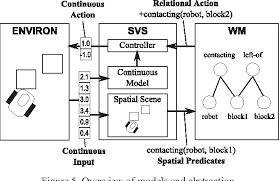
No matter if you are in the business or creating robots, the term "philosophy and artificial intelligence" is something you have probably heard before. In most cases, the field of AI focuses on the engineering of computational or cognitive artifacts. But what does the term really mean? What does this have to do about the future of humanity's existence? Let's explore some of the underlying ideas behind AI.
AI is concerned with engineering computational artifacts
Artificial intelligence (AI), which is a branch or computer science, focuses upon building intelligent artifacts. This field is operationalized through tests of human intelligence and other mental capabilities, such as mechanical ability and creativity. AI can solve a variety of problems, including those that involve discontinuities, gradients, and complex shapes. AI is used in engineering as well as science.

AI's origins were logic-based reasoning. Aristotle’s theory on the syllogism was one example of this. Earlier, humans used uncertain reasoning to determine what is "rational to believe in the light of certain observations and probabilities."
AI literature often focuses on engineering mechanized systems that can replicate human or animal mental abilities. Most of AI researchers focus on engineering computational artifacts, rather than on their own capacity to experience. This may be due to the formalism of the field. It is possible to determine how AI mimics human thought. This will give you a more precise measure of AI. While machines may not understand the complexities and behavior of humans, this is an important feature of AI.
AI is about engineering cognitive artifacts
Artificial intelligence (AI), which is the study of creating intelligent artifacts, is a branch of artificial intelligence. This field is operationalized through intelligence tests and other mental abilities tests. The Companions project is an example of a long-lived system which acts as a collaborator for humans. The Companions Project architecture attempts to address multiple AI challenges. These are some important points to remember when thinking about AI in the workplace.
AI is all about engineering cognitive artifacts which will allow humans to behave like AI. Therefore, it is important to understand the human mind. For instance, humans can learn a language. An artificial agent would, however not necessarily learn a natural tongue. AI is concerned in engineering computational artifacts. It can include a human-like vocalization and sometimes a human scale test.

Computers are capable of drawing inferences and deductively drawing conclusions. But true reasoning requires much more. In other words, true reasoning requires the ability to draw inferences about a specific situation or task. This aspect of AI is the most difficult. This is an attractive goal because of recent developments in AI. AI is a subject of research and application. But it has been slow in catching up to human-level advancements.
FAQ
Who was the first to create AI?
Alan Turing
Turing was born in 1912. His mother was a nurse and his father was a minister. He was an excellent student at maths, but he fell apart after being rejected from Cambridge University. He took up chess and won several tournaments. After World War II, he was employed at Bletchley Park in Britain, where he cracked German codes.
He died in 1954.
John McCarthy
McCarthy was born in 1928. Before joining MIT, he studied maths at Princeton University. The LISP programming language was developed there. In 1957, he had established the foundations of modern AI.
He died on November 11, 2011.
What is the future of AI?
The future of artificial intelligence (AI) lies not in building machines that are smarter than us but rather in creating systems that learn from experience and improve themselves over time.
We need machines that can learn.
This would allow for the development of algorithms that can teach one another by example.
We should also look into the possibility to design our own learning algorithm.
It is important to ensure that they are flexible enough to adapt to all situations.
Are there risks associated with AI use?
Of course. There will always exist. AI could pose a serious threat to society in general, according experts. Others argue that AI can be beneficial, but it is also necessary to improve quality of life.
The biggest concern about AI is the potential for misuse. It could have dangerous consequences if AI becomes too powerful. This includes autonomous weapons and robot rulers.
Another risk is that AI could replace jobs. Many fear that AI will replace humans. But others think that artificial intelligence could free up workers to focus on other aspects of their job.
Some economists even predict that automation will lead to higher productivity and lower unemployment.
What does AI mean today?
Artificial intelligence (AI), which is also known as natural language processing, artificial agents, neural networks, expert system, etc., is an umbrella term. It is also known as smart devices.
Alan Turing, in 1950, wrote the first computer programming programs. He was fascinated by computers being able to think. He presented a test of artificial intelligence in his paper "Computing Machinery and Intelligence." The test asks whether a computer program is capable of having a conversation between a human and a computer.
John McCarthy, who introduced artificial intelligence in 1956, coined the term "artificial Intelligence" in his article "Artificial Intelligence".
There are many AI-based technologies available today. Some are simple and straightforward, while others require more effort. They include voice recognition software, self-driving vehicles, and even speech recognition software.
There are two types of AI, rule-based or statistical. Rule-based uses logic to make decisions. To calculate a bank account balance, one could use rules such that if there are $10 or more, withdraw $5, and if not, deposit $1. Statistics are used for making decisions. To predict what might happen next, a weather forecast might examine historical data.
AI is useful for what?
Artificial intelligence is an area of computer science that deals with the simulation of intelligent behavior for practical applications such as robotics, natural language processing, game playing, etc.
AI can also be referred to by the term machine learning. This is the study of how machines learn and operate without being explicitly programmed.
Two main reasons AI is used are:
-
To make our lives easier.
-
To accomplish things more effectively than we could ever do them ourselves.
Self-driving vehicles are a great example. We don't need to pay someone else to drive us around anymore because we can use AI to do it instead.
What are some examples of AI applications?
AI can be applied in many areas such as finance, healthcare manufacturing, transportation, energy and education. Here are just some examples:
-
Finance - AI has already helped banks detect fraud. AI can detect suspicious activity in millions of transactions each day by scanning them.
-
Healthcare – AI is used for diagnosing diseases, spotting cancerous cells, as well as recommending treatments.
-
Manufacturing - AI can be used in factories to increase efficiency and lower costs.
-
Transportation - Self driving cars have been successfully tested in California. They are now being trialed across the world.
-
Utilities can use AI to monitor electricity usage patterns.
-
Education - AI is being used for educational purposes. Students can use their smartphones to interact with robots.
-
Government - AI is being used within governments to help track terrorists, criminals, and missing people.
-
Law Enforcement - AI is being used as part of police investigations. Search databases that contain thousands of hours worth of CCTV footage can be searched by detectives.
-
Defense – AI can be used both offensively as well as defensively. An AI system can be used to hack into enemy systems. Protect military bases from cyber attacks with AI.
How does AI function?
To understand how AI works, you need to know some basic computing principles.
Computers save information in memory. Computers process data based on code-written programs. The code tells the computer what it should do next.
An algorithm is an instruction set that tells the computer what to do in order to complete a task. These algorithms are typically written in code.
An algorithm can be considered a recipe. A recipe can include ingredients and steps. Each step represents a different instruction. A step might be "add water to a pot" or "heat the pan until boiling."
Statistics
- More than 70 percent of users claim they book trips on their phones, review travel tips, and research local landmarks and restaurants. (builtin.com)
- The company's AI team trained an image recognition model to 85 percent accuracy using billions of public Instagram photos tagged with hashtags. (builtin.com)
- According to the company's website, more than 800 financial firms use AlphaSense, including some Fortune 500 corporations. (builtin.com)
- By using BrainBox AI, commercial buildings can reduce total energy costs by 25% and improves occupant comfort by 60%. (analyticsinsight.net)
- While all of it is still what seems like a far way off, the future of this technology presents a Catch-22, able to solve the world's problems and likely to power all the A.I. systems on earth, but also incredibly dangerous in the wrong hands. (forbes.com)
External Links
How To
How to set Siri up to talk when charging
Siri can do many things, but one thing she cannot do is speak back to you. This is because your iPhone does not include a microphone. Bluetooth is a better alternative to Siri.
Here's how to make Siri speak when charging.
-
Select "Speak When locked" under "When using Assistive Touch."
-
Press the home button twice to activate Siri.
-
Siri can speak.
-
Say, "Hey Siri."
-
Say "OK."
-
Speak up and tell me something.
-
Say, "I'm bored," or "Play some Music," or "Call my Friend," or "Remind me about," or "Take a picture," or "Set a Timer," or "Check out," etc.
-
Speak "Done."
-
If you would like to say "Thanks",
-
If you're using an iPhone X/XS/XS, then remove the battery case.
-
Insert the battery.
-
Place the iPhone back together.
-
Connect your iPhone to iTunes
-
Sync the iPhone
-
Set the "Use toggle" switch to On